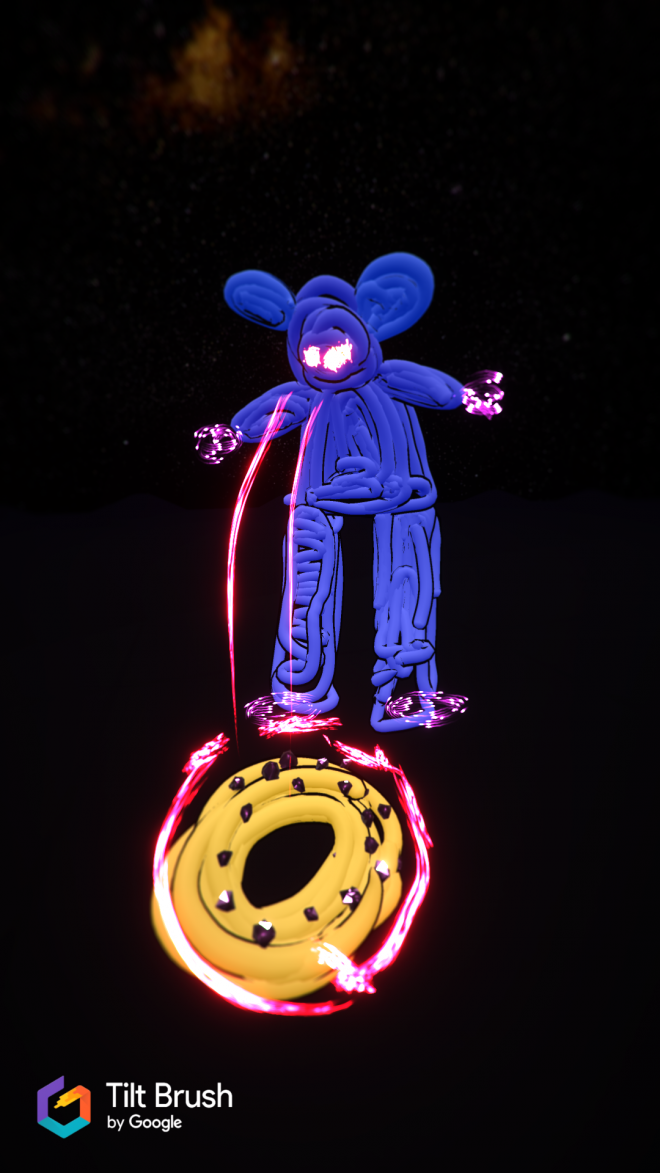Back to Reality
Brooke Sauvage stops by VR Arcade NOLA and tries her hand at drawing in virtual reality.

A drawing by the author created with Google’s Tilt Brush software.
Last month, David Denny and Devin Regan, the owners of VR Arcade NOLA, invited me to a warehouse turned shared workspace in the Lower Garden District for my first experience in virtual reality. Playing with the Google Tilt Brush was deeply amusing, almost opiate in its novelty. Once you don the glasses, the interface allows you to paint three-dimensional brushstrokes—in fire, smoke, and disco swaths—in various backgrounds, including outer space. You can conjure a snowman and paint neon-green, star-shaped eyes on his face, with a fat mouth drawn in pink marker. You can teleport from here to there with the click of a button like the Little Prince visiting faraway planets. You can scale your creations up and down, as if you were Alice down the rabbit hole, testing potions at the door of perception. In the world of virtual reality, you can do just about anything—so long as it is composed out of pixels.
When I first arrived at VR Arcade, I had the distinct impression that there would be no going back—that my first time experiencing virtual reality would be something I recalled to future grandchildren huddled around me as I sat on a digitally composed armchair: Ah, yes, I remember that day, the day I spun around a fluorescent-lit room in bulky glasses, laughing like a maniac at the sudden, immersive novelty of living inside of a Photoshop file. I am by no means a luddite, though I had assured Denny via email prior to my visit that he would have to convince this mighty analogue girl that virtual reality was a world worth exploring—and not just one that would convert users into drooling, overweight serfs bidden to Jeff Bezos.
VR Arcade NOLA, as Denny explained, largely caters to conventions, trade shows, and private parties in providing virtual-reality experiences. They might do an underwater simulation for an event at the Audubon Aquarium, for instance, where users can swim through the Great Barrier Reef. He encourages his clients, “Leave the photo booth behind and try out virtual reality!” Aside from its clear entertainment value, virtual reality is being hailed as a progressive, educational force in many industries. For instance, programs exist that take users through environments hit by deforestation and climate change in an attempt to re-sensitize issues through experience that are too often processed as blips in the news headlines. Another project, the VR Museum of Fine Art, allows users to tour a selection of historic artworks, irrespective of time or space, in 1:1 ratio. The Google Tilt Brush allows users to paint over a dress form, as if they were designing clothes; architects could equally walk around inside of a CAD drawing and build a structure as if they were standing inside of it.
Perhaps it is telling of my disposition, however, that my first forays into virtual reality were spent making pulsating, rainbow cages that I hid beneath before teleporting away towards unreachable mountains looming on the digital horizon. It reminded me of how Albert Camus’ characters must have felt—exquisitely, existentially minute—looking into the desert at night. Once I finished grappling with the parameters of my digital existence, however, I made myself a friend, a fellow being to share the horizon with: a mouse-man with laser-beam eyes eating a doughnut in space. It was the kind of thing that, if left to my own devices, I could see my roommate discovering me at three in the morning, in my underwear, gesturing at the walls in big, empty brushstrokes, with the black glasses strapped on my face, entranced by a labyrinth of my own making.
When I took the glasses off, I felt like Michael Jordan in Space Jam, when he’s sucked from the cartoon world through the spiraling Warner Brothers banner and unceremoniously dumped back into the real world, where he dons khakis and plays golf to bury his insecurities. Like all of the best things in life, virtual reality presents itself as a double-edged sword. On one hand, you can do so much. The Google Tilt Brush is wildly fun and certainly has educational, creative, and commercial applications. On the other hand, it dovetails all too easily with an avalanche of debilitating consumerism. I can imagine the sales pitch: Don’t worry folks, if you don’t want to talk to people, or even leave your house, you don’t have to! Simply wear these glasses all the time, and purchase anything you need with one blink, maybe two! Have it materialize in front of your eyes! No need to get the door, the product will be delivered via drone, in front of your face!
When artists create, it is nothing short of magic: We take dreams, whispers from the world, and spin them into pieces imbued with feeling, pieces that can be shared, pieces that can inspire others, from disparate corners of the human continuum. Pieces that remind us that, as humans, we all respond to the same bleeding heart, animating and illuminating each move that we make.
Sure, once you invest the initial thousands of dollars to set up the Google Tilt Brush, you can create things instantaneously, marvelously, that can be exported as a GIF or JPG for later consideration. But nothing that issues forth from the Google Tilt Brush can be touched. Nothing it produces can be felt, held, cradled, hugged, or hung on the wall. Because it does not exist in the physical realm. It is image only. So then, what if we accepted our material world as virtual reality too? What if we embraced the notion that what we carry in our heads and hearts—the intangible, our dreams—are the very tools that populate our daily realities?



